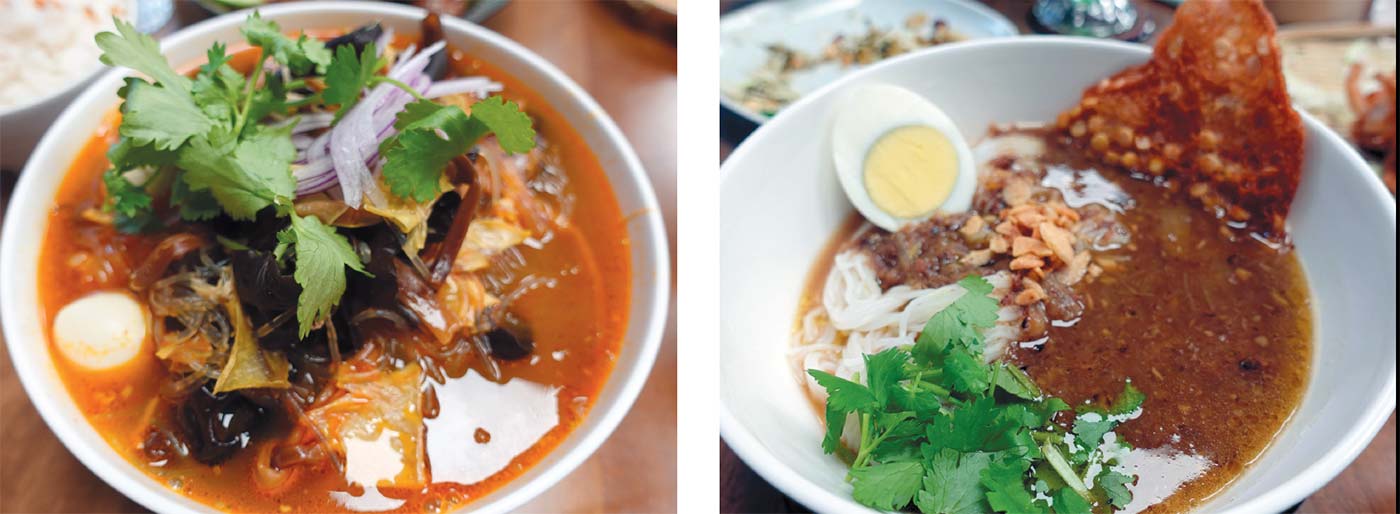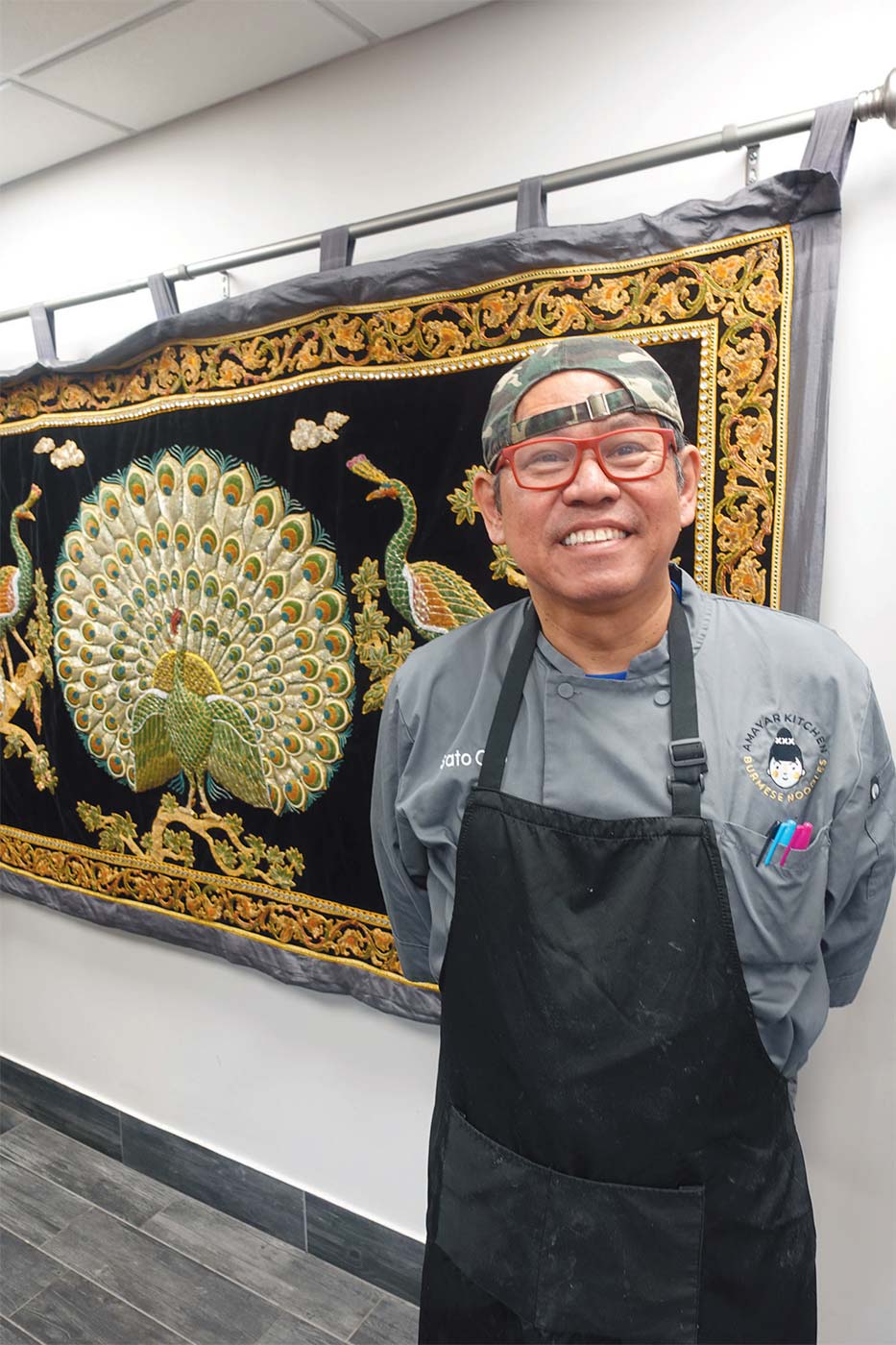Home-Cooked Burmese Classics in Maywood
On a chilly, misty winter day, I set out with two companions to Amayar Kitchen in Maywood. We craved the steaming bowls of soup and stew that have made the restaurant famous. Despite many visits to Southeast Asia between us, we knew little of Burmese food or culture.
Amayar Kitchen greeted us with an aroma of simmering curry and stewed chicken, touched with a light, sharp dash of fresh cilantro. A gentleman with red-framed glasses and a smile that filled his whole face approached us and shook our hands, greeting us newcomers as if we were old friends.
Aung “Sato” Myint is the owner and head chef. He calls his domain a kitchen, not a restaurant, as he thinks of it as an extension of his home. On the day we visited, his wife, Lynn, and his middle daughter Ruth worked alongside him. They described their food as the sort that Burmese grandparents would prepare.
Sato got his nickname as a youth, from his grandfather who had moved to Japan to work as a fisherman. Sato means “sweet” in Japanese, an apt word for the chef’s friendly nature. Sato was born in Yangon (Rangoon), Myanmar’s largest city, which nestles against a river of the same name. His father worked a civil service job as a traveling doctor, so Sato was often on the move. He saw most of the country and sampled diverse Burmese cuisines.
Burma was the country’s official name for many generations, though the military group that took over the government in 1989 changed the name to Myanmar. Still, one born there is referred to as Burmese; Sato refers to the country as Burma because he lived there as a youth before the takeover. As an outsider to a politically complex country, I call it Myanmar in line with how it is known by most of the world.
Myanmar is divided into seven states and seven divisions. Sato described the country’s regional districts in simpler terms, as North, East, South, and West. He explained that each region has distinct culinary traditions. The country formally recognizes 135 ethnic groups, reflected in the Thai, Indian, and Chinese influences on Myanmar’s food culture, which even an untrained palate can recognize. Yet Burmese cuisine includes far more influences, including the marked legacy of Britain’s colonial occupation of the country from 1824 until 1948.
The complexity of the food at Amayar Kitchen makes one marvel that Sato has had no formal chef’s training. His mother didn’t even allow him in the kitchen as a child, often relegating him to the task of butchering chickens when he wanted to help with a meal. He learned simply by observing others during his travels and eating his way around Myanmar.
Sato opened Amayar Kitchen in November of 2020, in the heart of the pandemic, when many businesses were closing for good and patrons were wary of public gatherings. He had previously spent many years working a variety of jobs in NYC’s Diamond District, in a college cafeteria, and in the mailroom for UNICEF.
Hardly more than a month after he opened, Sato’s mother fell ill with the virus. She passed away in January 2021.
“My mother was never able to see my kitchen,” Sato explains, in between describing the multitude of dishes he was placing before me. “So, this place has become a tribute to her.” His face beamed with pride.
Sato relishes the opportunity to cook for patrons in America who have deep connections to family abroad.
“I have had people cry and tell me, ‘This is like my mother’s cooking’,” he says. “There are South Indians who taste familiar flavors in my curries. There are Pakistanis who have Burmese grandparents who feel like they are back in their home kitchen when they taste my food.
THE COUNTRY FORMALLY RECOGNIZES 135 ETHNIC GROUPS, REFLECTED IN THE THAI, INDIAN, AND CHINESE INFLUENCES ON MYANMAR’S FOOD CULTURE, WHICH EVEN AN UNTRAINED PALATE CAN RECOGNIZE. YET BURMESE CUISINE INCLUDES FAR MORE INFLUENCES.

After carefully considering the menu’s offerings and Sato’s recommendations, we ordered more food than three people could ever eat. The first dish to arrive was Burmese Tea Leaf Salad, known as Lahpet Thoke. Lahpet are fermented green tea leaves that were often exchanged in ancient times as a symbol of peace between warring Burmese kingdoms. The dish is commonly provided as a snack or eaten after a meal in Myanmar, but at Amayar its function was to awaken our appetites. The tea leaves are tossed with cabbage, tomatoes, cilantro, and a crunchy mix of peanuts, garlic chips, chickpeas, sunflower seeds, and sesame seeds, not unlike a savory trail mix. The result is a light, floral salad, with a fragrance like a deep breath over a freshly brewed cup of tea. Put a big bowl of this salad in front of me with nothing else, and I would be more than satisfied.
Next to arrive was mohinga, a bowl of rice noodle soup with a black pepper fish stock and layers of flavors that hit you in waves: onion, egg, peanuts, garlic, ginger, fish sauce, and lemongrass. The noodles absorb the rich, peppery broth and take on a velvety texture. Conversation ceased, and talking was replaced by the sounds of slurping noodles and the clinking of spoons scraping the last drops of savory broth from our bowls. With bellies now warm and buzzing, we exchanged nods and affirmations of pleasure.
A packed bowl of chicken and potato curry was soon placed on the table. The chicken was juicy, tender, pulled apart as easily as if it were melting. We soaked up the curry with bits of potato and some of Sato’s homemade chili pepper chips that sent up a jolt of heat.
Our visit coincided with a special offering of Kyar Zan Kyat, Burmese chicken soup, not on the regular menu. The soup must be made fresh and served immediately, as the noodles become mushy if it’s prepared too far in advance. This dish had everything, all kinds of flavors and textures: glass noodles, hard-boiled quail eggs, tender chicken, chewy wood ear mushrooms, chopped red onion, and fresh cilantro, all swimming in a fiery red-orange broth. This certainly wasn’t the chicken soup of my youth, which often came from a can or in an instant form with a spice packet and was used as a home remedy for the common cold. Nonetheless, it was clear that this soup would nurse any weakened or weary eater back to health. Once we consumed all the tasty bits we unabashedly lifted our bowls upwards and downed the remaining broth.
Kyar Zan Kyat accompanied a Burmese chicken salad, creamy and refreshing, but with hidden finely chopped green chilies hot enough to set our taste buds on fire. It was far from the raisins, walnuts, and celery variations of chicken salads I have eaten over the years, but after the sense-scorching, tear-inducing goodness of the Burmese version there can be no going back.

Aung “Sato” Myint
Fully sated, there was no real need for dessert, but when banana leaf sticky rice was placed before us, still steaming and smelling of coconut, we gladly sank our forks into the treat. A sweet coconut and cinnamon sauce on the side tasted akin to a hot bowl of morning oatmeal, an unexpected flavor to finish the meal.
Breathing deeply, with hands resting on our now-full stomachs, we sat and listened to Sato’s daughter’s tales of her father in the kitchen and his experiences as a youth. Sato moved from table to table, greeting regulars and introducing himself to first-time customers. The scene recalled holiday family gatherings of my youth. The flavors were different, but the effect was the same.
Sato’s dream of creating a homestyle kitchen has come to fruition, and his food reaches across cultures. I’m certain that when we return, it will be like coming home once more.
AMAYAR KITCHEN
111 E Passaic St., Maywood
201.881.0588
facebook.com/amayarkitchen





